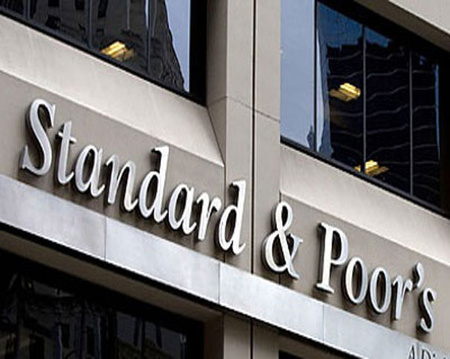Baku, Azerbaijan, Sep. 14
By Elena Kosolapova - Trend:
Standard & Poor's Ratings Services affirmed its long-term foreign and local currency sovereign credit ratings on the Republic of Kazakhstan at 'BBB', the rating agency reported on Sep. 14
At the same time the rating agency affirmed the short-term foreign and local currency ratings
at 'A-2' and the Kazakhstan national scale rating at 'kzAA+'.
The outlook on the long-term ratings remains negative.
"The ratings on Kazakhstan continue to be supported by the general government's net asset position, which follows recent years of fiscal and external surpluses. The ratings remain constrained by our view of Kazakhstan's limited institutional and governance effectiveness owing to the highly centralized political environment, moderate level of economic development, limited monetary policy flexibility, and
high dependence on the hydrocarbon sector," S&P said.
On Aug. 20, Kazakhstan's authorities announced a shift to inflation targeting and a more flexible exchange rate policy. This move was followed by an immediate 26 percent depreciation of the tenge against the U.S. dollar.
"Although the announced shift to a more flexible exchange rate policy under the inflation-targeting framework could potentially increase monetary policy flexibility and Kazakhstan's capacity to deal with external shocks, the ability and commitment of the Kazakh National Bank to follow the new monetary policy regime remains to be tested. This is given what we regard as the so far weak effectiveness of Kazakhstan's monetary policy, which makes it difficult to transition to full inflation targeting
in a short period," the rating agency said.
According to S&P, the ability to impact domestic monetary conditions will also be constrained by the banking system, which still remains vulnerable and has become increasingly dollarized. The share of foreign-currency deposits in total deposits has remained consistently high, at above 50 percent over the last few months (52 percent in July), compared with below 40 percent two years ago. The recent devaluation will likely increase dollarization further, in S&P's view.
Moreover, Kazakhstan's financial system is vulnerable, the agency said. Following significant reduction of nonperforming loans (NPLs) in June 2015 (thanks to the removal of the majority of NPLs from defaulted banks BTA Bank and Kazkommertsbank from the banking system's balance sheet), S&P expects NPLs to increase in the second half of 2015 and in 2016.
"The increase will be driven, in our opinion, by economic slowdown, the tenge devaluation (given that about 23 percent of loans are in foreign currency), and seasoning of loans disbursed by banks that have been growing aggressively over the past four years" the agency said.
According to S&P, significant risks to the stability of the banking system remain tight tenge liquidity and a material mismatch of assets and liabilities in foreign currency, especially in retail banking, which the agency does not expect to reduce significantly in the next 12 months.
This faces the NBK with increasingly difficult monetary policy decisions, especially given the expected hike in inflation, the rating agency said.
Kazakhstan's medium-term growth outlook remains constrained, due to weak external demand and lower and increasingly volatile oil prices, S&P said.
Since Kazakhstan's economy depends heavily on the oil sector--which accounts for an estimated 20 percent of GDP, 50 percent of fiscal revenues, and 60 percent of exports--we expect GDP growth to slow to 2.8 percent in 2015-2018 against an average of 6 percent in 2010-2014, according to S&P.
The scenario assumes the limited contribution of net exports to GDP due to what S&P forecasts as flat oil production, unless the large offshore Kashagan oil field comes fully onstream earlier than 2018. The growth outlook is also dampened by the expected impact on consumer demand from currency devaluation and weak consumer lending, as well as lower-than-expected exports of other raw materials.
"Growth in 2015-2016 will likely be supported by the government's stimulus program, which implies infrastructure and housing investments and support of small and midsize enterprises. Longer-term growth prospects will depend, however, on the pace of the oil price recovery, the Kashagan oil field project's implementation, stronger consumer demand, and progress in the announced structural reforms," S&P said.
The agency believes Kazakhstan's capacity and willingness to contain expenditures in the medium term, after the ongoing stimulus has finished, remains strong, and it anticipates that the general government will return to a surplus position from 2017.
As a result of lower oil prices, Kazakhstan's external performance is likely to be weaker than in the recent past, S&P said. The agency expects the current account to deliver modest deficits of about 2.5-3 percent of GDP on average in 2015-2017.
"However, a gradually recovering oil price and a more flexible exchange rate could put the current account back into surplus by 2018, in our view," the agency said.
The negative outlook on the long-term ratings reflects S&P's view of existing risks to Kazakhstan's external, fiscal, and monetary profiles. The agency could consider lowering the long-term ratings if Kazakhstan's external and fiscal positions deteriorate beyond the current expectations in the next two years. The ratings could also come under pressure the agency came to the conclusion that the National Bank had stepped back from its commitment to a flexible tenge exchange rate and inflation targeting.
S&P could revise the outlook to stable if higher oil prices, as well as Kazakhstan's planned robust fiscal and monetary policy response, remove pressure from the country's fiscal, external, and monetary conditions.
Follow the author on Twitter: @E_Kosolapova






